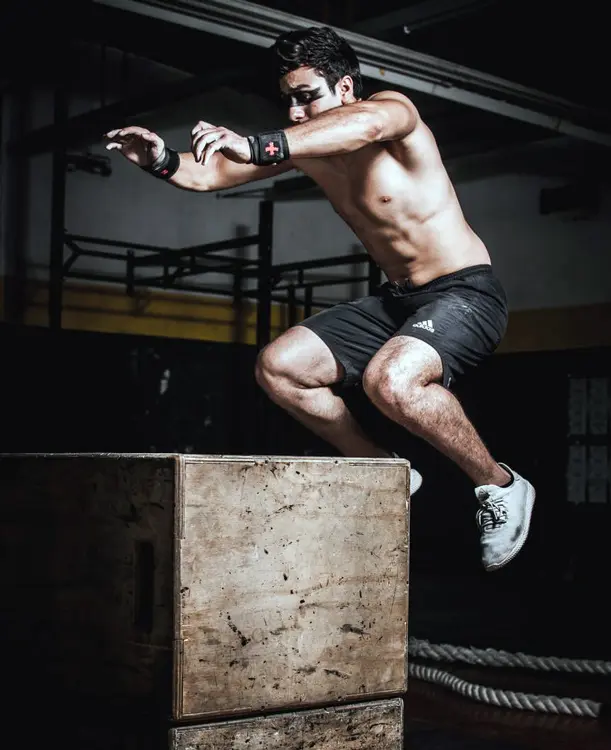You’re probably thinking this is an off-kilter topic but fitness and sports performance go hand-in-hand. And a lot of people want to know how to jump higher which is incredibly useful for essentially all sports that require any kind of physicality.
Now, you may not be flying across court and hanging from the rim with your elbow like Vince Carter anytime soon (or ever for that matter because it depends on the individual) but by training to improve your vertical leap, you can make some pretty amazing progress.
So, we’ll do our best to provide you with some information that you can go out and apply to your training as soon as you’re done reading…
Jump Training Research
First off, we’ll look at what research shows for improving vertical leap.
One study concluded that squat jump training with individualized loads that allow repetitions to be performed ≥90% of maximum average power output over an 8-week period; improves many aspects of athletic performance including vertical jump. But, it was also noted that vertical jump improvement fell off after 4 weeks as well. (1)
However, there are always more variables to be considered when it comes to individual training and performance.
Level Up Your Fitness: Join our 💪 strong community in Fitness Volt Newsletter. Get daily inspiration, expert-backed workouts, nutrition tips, the latest in strength sports, and the support you need to reach your goals. Subscribe for free!
There was another study which set out to determine how effective plyometric training (PT) is for improving vertical jump. And this research found that PT significantly improves jump performance in the four different types of vertical jumps (squat jump (SJ); countermovement jump (CMJ); countermovement jump with the arm swing (CMJA); and drop jump (DJ)) with a mean effect in jump height ranging from 4.7%-8.7%. (1)
So, plyometric training is a must for improving your vertical jump and it seems to be the popular method for improving performance in this area.
Now yes, building strong legs with weight training, in general, is crucial but you also need to be training relative to the actual activity.
And movements that simulate the jump in an explosive manner are naturally going to be very effective. However, you’ll still need to work on other important components as well.
But most of all… there are no shortcuts either and you’ll have to put in the work to see results as with anything else.
Ok so first, let’s talk about what is involved in the jump.
Well, we know that by the movement of the body during a proper jump, the hip flexors, core, Achilles tendon, and latissimus dorsi are all essential contributors to propelling your body upward.
And you must have triple extension in hips, knees, and ankles to reach maximum heights, therefore, you want to keep these areas as loose as possible.
So, performing some stretches is a great way to improve and maintain this.
Here are a few examples…
Achilles stretch
Perform some of the examples in the video and hold for at least 30 seconds. Perform this stretch alternating bending your knees and keeping them straight to also stretch both heads of the calf muscles which are the soleus and gastrocnemius.
Hip flexor stretch
Note: Only stretch your hip flexors if they’re tight because sometimes weak muscles are mistaken for tightness and stretching weak hip flexors can worsen any potential issues.
But here’s a simple way to stretch your hip flexors.
Hold this position for 30-45 seconds and then switch sides.
Lat stretch
https://youtu.be/jXB-gTLFDp8
Hold this stretch for about 20-30 seconds and repeat on the other side.
The 4 Best Exercises for Jumping Higher
The following exercises are really going to help anyone jump higher because each one targets the different specific components necessary to elevate yourself to maximum height.
1. Kettlebell swing
The kettlebell swing simulates the jump and you also get the explosive, athletic component with the triple extension of the hips, knees, and ankles. But the kettlebell swing also works the posterior chain from the calves to the hamstring, glutes, core, and back which all assist in the jump.
Train this both heavy and light to benefit from the strength and explosive improvements.
2. Squat Onto Toes
There’s a muscle in the foot called the flexor hallicus longus which flexes the big toe but it also crosses the ankle joint. And you should work on strengthening this muscle to help maximize your vertical jump. It won’t make a massive difference but any little extra help you can get is well worth your time.
So, to really load this muscle we’ll have the additional weight of the barbell on your back. You’ll perform the squat then immediately transition onto your toes in an explosive manner as if you were doing a calf raise.
You can also do a version of the standing calf raise which involves triple extension but in an explosive way.
3. Box Jump
The box jump is a staple for athletes looking to improve their vertical jump performance because you’re actually jumping explosively and then you get the benefit of the stretch reflex which will help you during actual jumping activities like for sports.
Now, it’s common to lift your knees as high as you can toward your torso during this type of exercise. But when aiming for pure standing vertical height, you want to train accordingly.
So, when you do jump onto a box or bench, your knees should not lift bent to where you’re crouched down. You want to explode through the ground and land closer to an upright position. Then, step back down to ease the impact on your knees.

4. Just Jump!
You want to know how to jump higher? Get jumping whether you’re just practicing while engaging in your sport/s of choice, jumping rope, and/or jumping with a little extra resistance.
Set a mark on the wall or on something free hanging and then try to reach it. When you’ve touched it move the mark up a little higher. This is also great for the mental aspect of improving performance because if you see your target and you’re driven to get to the mark then you’re going to hit it.
The mind is a powerful component of essentially every aspect when it comes to physical and mental performance.
For example, you’ve probably seen athletes (or anyone who has achieved an incredible feat) get into a zone and accomplish exactly what they said they would in an unexplainable manner (visualization is powerful).
Wrapping Up
You now have the knowledge and tools to go out there jump higher. So, remember the important points from above from the stretching of muscles to the strength-building and explosive exercises and finally the mental component.
But most importantly, you have to practice, practice, practice because without that, well… you probably won’t experience your maximum potential.









Great exercises.
Kettlebell swings are especially fun for getting in that full range of motion at an intense pace. You could also do it with dumbbells, but I find kettlebells better since I can get a better grip on them and the position feels more natural.
I’d also recommend some other exercises that are equally as effective. This article mentions a few of them but exercises like jump roping and broad jumps with the medicine ball work extremely well in conjunction with the exercises mentioned here.